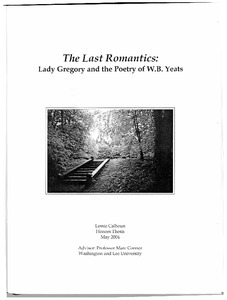| dc.rights.license | In Copyright | en_US |
| dc.creator | Calhoun, Lessie Lee | |
| dc.date.accessioned | 2023-10-20T15:49:28Z | |
| dc.date.available | 2023-10-20T15:49:28Z | |
| dc.date.created | 2004 | |
| dc.identifier | WLURG038_Calhoun_thesis_2004 | |
| dc.identifier.uri | https://dspace.wlu.edu/handle/11021/36269 | |
| dc.description.abstract | Beginning in 1896, W. B. Yeats spent more than twenty summers at Coole Park with Lady Gregory. There they collaborated on plays, gathered folklore, and he wrote poetry. She was an invaluable aid to him in recovering from a near breakdown caused by a serious nervous condition. Afterwards, Coole Park remained for him a place of respite and of peace. Lady Gregory rescued him from failing health and brought him to Coole -- a place of wellbeing and
productivity. He wrote of his first stay at Coole Park: "My life was giving way, my nerves had been wrecked. Finding that I could not work and thinking open air salutary, Lady Gregory brought me from cottage to cottage collecting folk tales." As many scholars have noted, her influence on his life is very important. However, her impact on the styles and themes of his poetry is notable as well and has received less critical commentary. . . . Yeats was profoundly affected by Lady Gregory and her home and shows this clearly by writing so extensively about them. Yeats and Lady Gregory also collaborated on prose collections of folklore and on plays for the Abbey Theater. The work that these collaborations produced is demonstrably a combination of both minds. Lady Gregory wrote most of the dialogue for the plays and was responsible for the examples of peasant speech in the folklore collections. Thus Yeats's work shows the influence of Lady Gregory both in the content of his poems and in the style and substance of his prose works. As a figure of primary importance in Yeats's life, Lady Gregory could be expected to have an important influence on his poetry. Her thematic influence is most importantly as a figure of stability and tradition, a representation of Yeats's ideal of nobility. However, she affected Yeats's style through her own efforts to
capture the sound of peasant speech. His poetry strives to preserve the power and purity of common language in order to communicate it with all Irish people. Thus a woman depicted as a symbol of nobility and refinement guided Yeats's poetry in the opposite direction, toward the language of the common people. [From Introduction] | en_US |
| dc.format.extent | 59 pages | en_US |
| dc.language.iso | en_US | en_US |
| dc.rights | This material is made available for use in research, teaching, and private study, pursuant to U.S. Copyright law. The user assumes full responsibility for any use of the materials, including but not limited to, infringement of copyright and publication rights of reproduced materials. Any materials used should be fully credited with the source. | en_US |
| dc.rights.uri | http://rightsstatements.org/vocab/InC/1.0/ | en_US |
| dc.subject.other | Washington and Lee University -- Honors in English | en_US |
| dc.title | The Last Romantics: Lady Gregory and the Poetry of W. B. Yeats | en_US |
| dc.type | Text | en_US |
| dcterms.isPartOf | WLURG038 - Student Papers | en_US |
| dc.rights.holder | Calhoun, Lessie Lee | en_US |
| dc.subject.fast | Yeats, W. B. (William Butler), 1865-1939 | en_US |
| dc.subject.fast | Gregory, Lady, 1852-1932 | en_US |
| dc.subject.fast | Irish poetry -- Criticism, interpretation, etc. | en_US |
| local.department | English | en_US |
